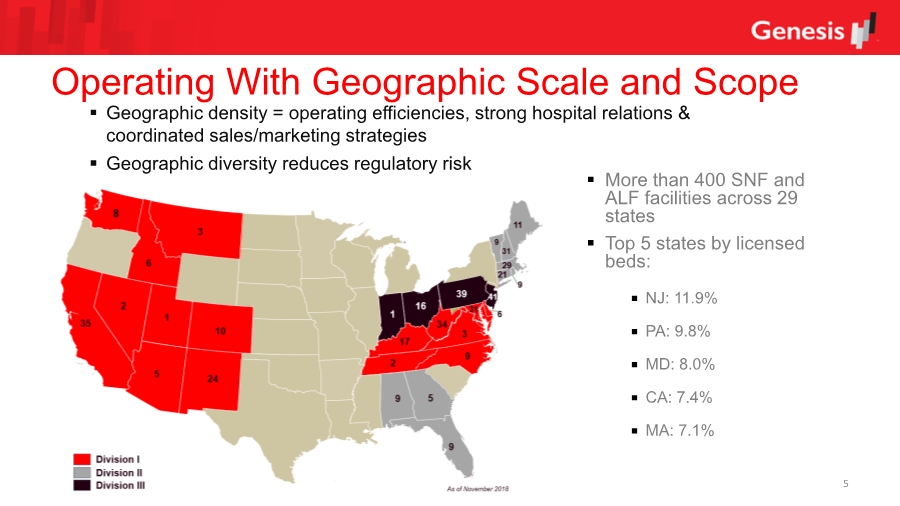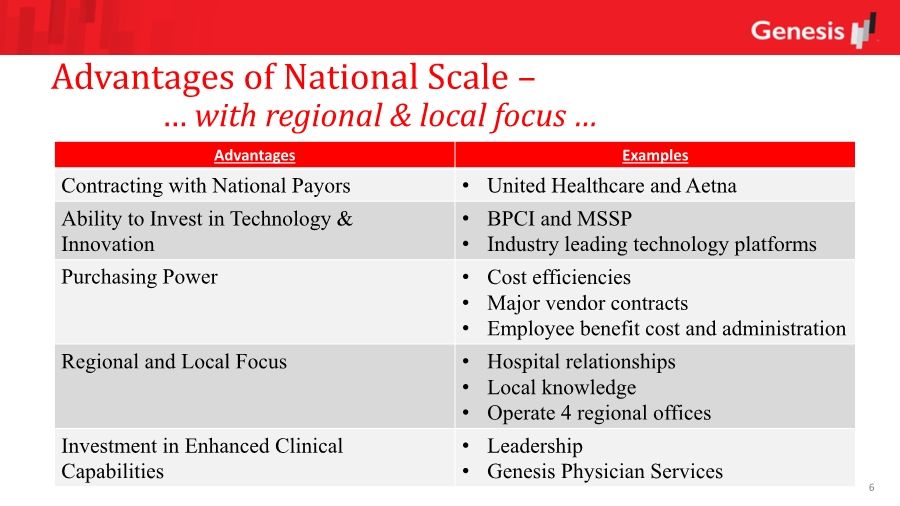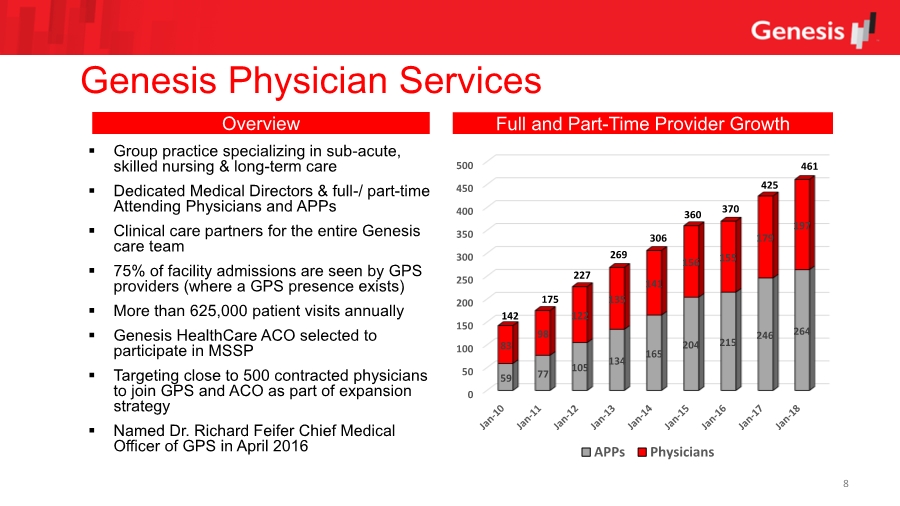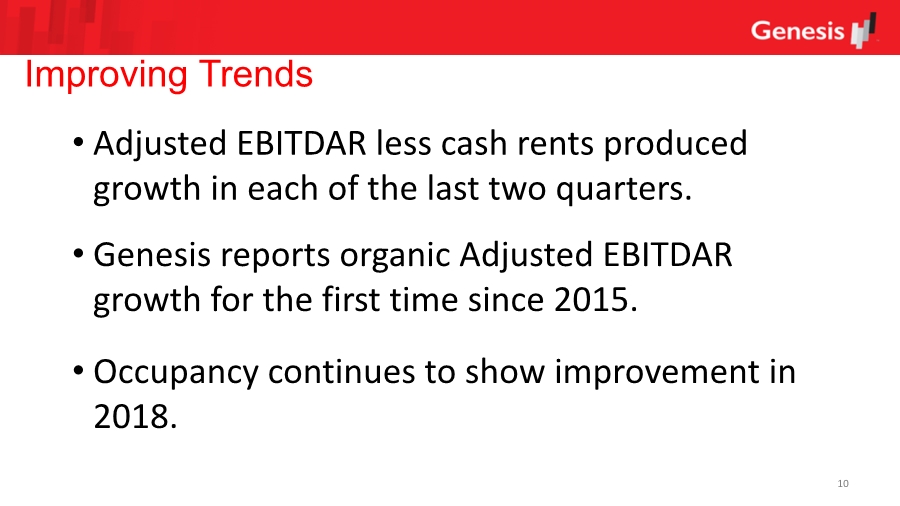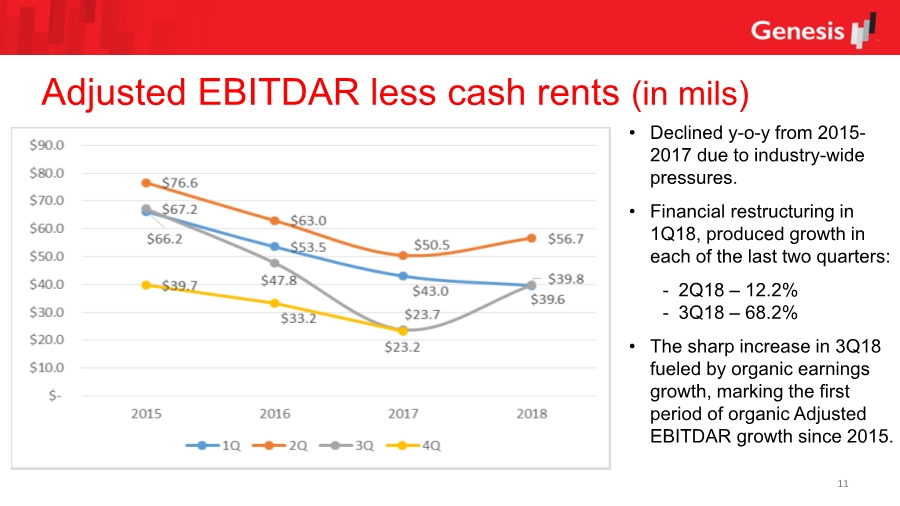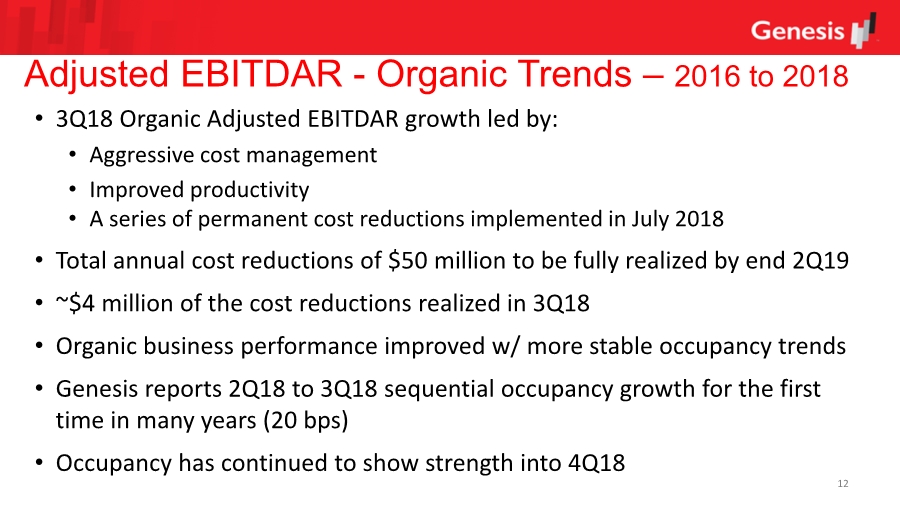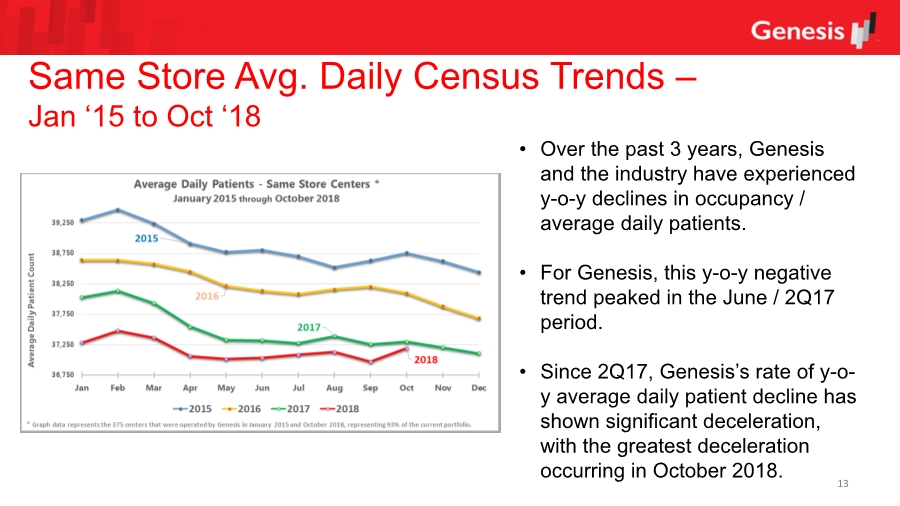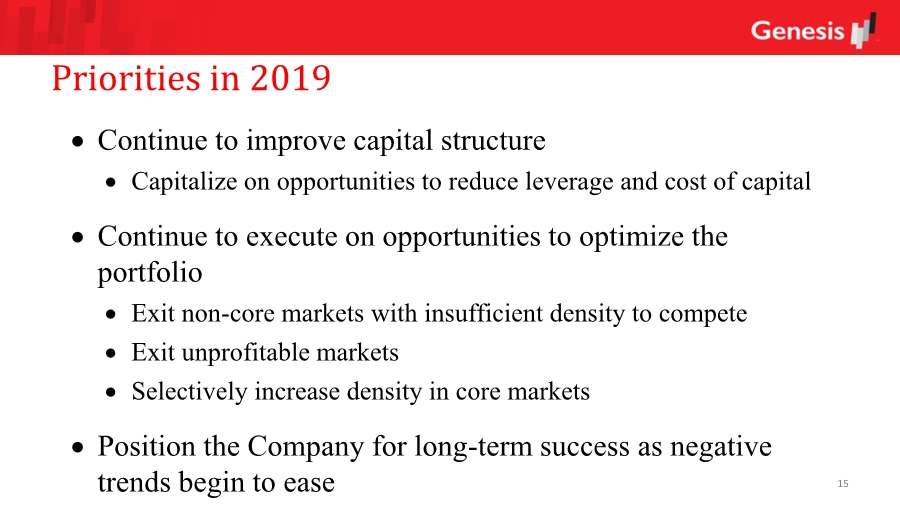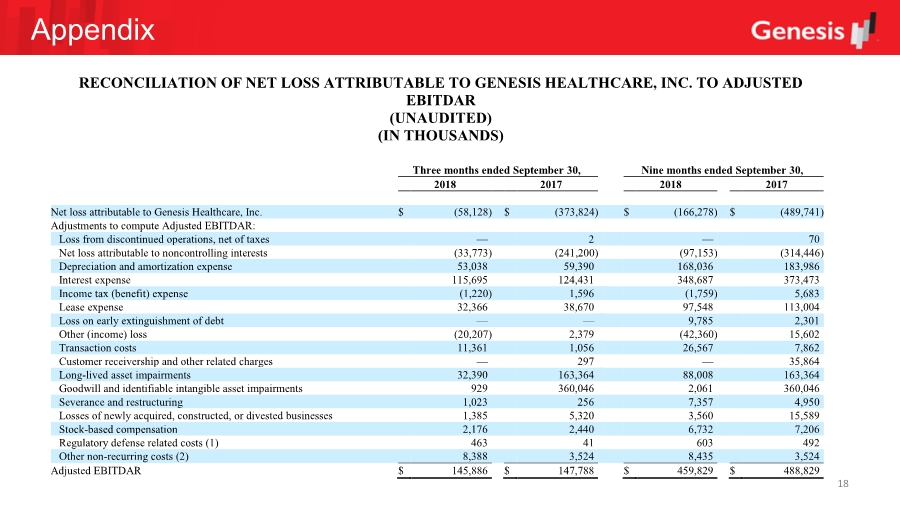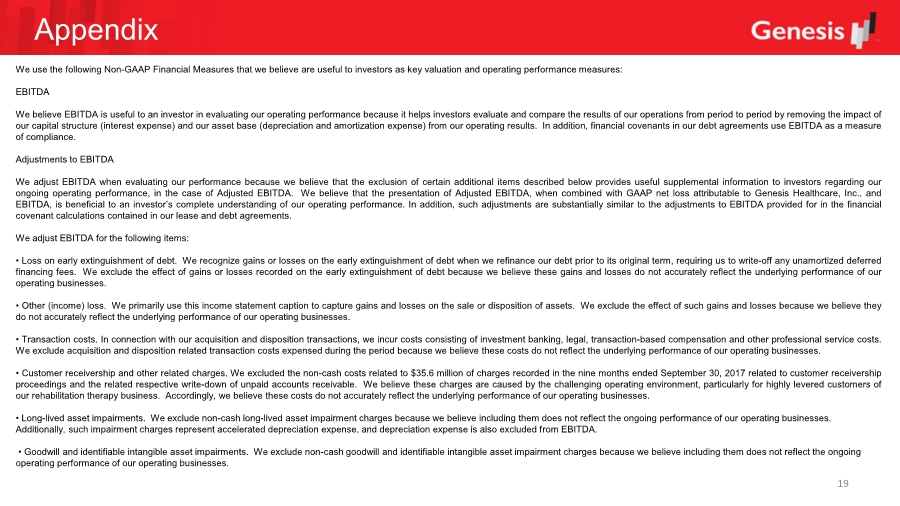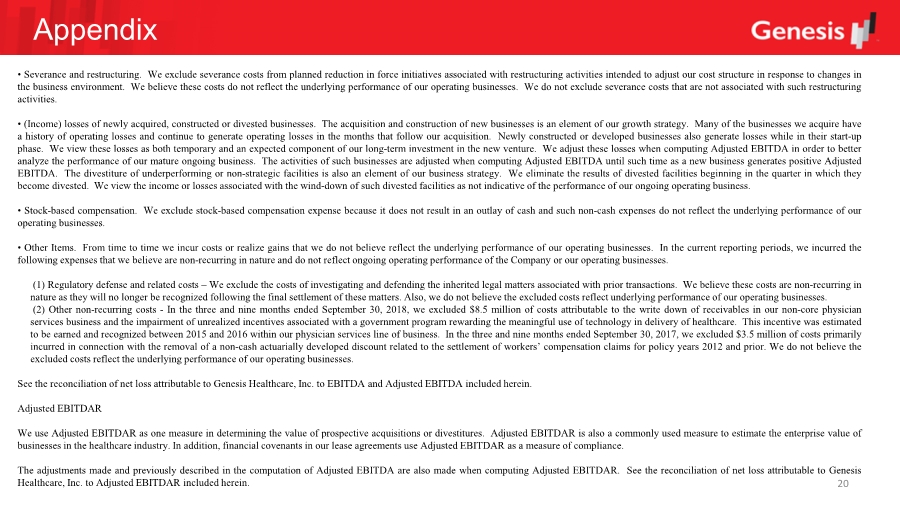Attached files
| file | filename |
|---|---|
| EX-99.1 - EX-99.1 - Genesis Healthcare, Inc. | ex-99d1.htm |
| 8-K - 8-K - Genesis Healthcare, Inc. | f8-k.htm |
Exhibit 99.2
| © 2018 by Genesis Healthcare, Inc. All Rights Reserved. A leading provider of post-acute services November 2018 |
| Safe Harbor Statement Certain statements in this presentation regarding the expected benefits of future opportunities for the Company and any other statements regarding the Company’s future expectations, beliefs, goals, strategies or prospects contained in this presentation constitute “forward-looking statements” under Section 27A of the Securities Act of 1933 and Section 21E of the Securities Exchange Act of 1934. Forward-looking statements may be preceded by, followed by or include the words “may,” “will,” “believe,” “expect,” “anticipate,” “intend,” “plan,” “estimate,” “could,” “might,” or “continue” or the negative or other variations thereof or comparable terminology. A number of important factors could cause actual events or results to differ materially from those indicated by such forward-looking statements, including changes in the Company’s reimbursement rates; healthcare reform legislation; the impact of government investigations and legal actions against the Company’s centers and other factors described in the most recent Annual Report on Form 10-K of the Company and elsewhere in the Company’s filings with the Securities and Exchange Commission. You should not place undue reliance on any of these forward- looking statements. Any forward-looking statement speaks only as of the date on which it is made, and the Company undertakes no obligation to update any such statement to reflect new information, or the occurrence of future events or changes in circumstances. References made in this presentation to "Genesis," "the Company," "we," "us" and "our" refer to Genesis Healthcare, Inc. and each of its wholly-owned companies. 2 |
| . Genesis Overview . Financial Review Agenda |
| Genesis Overview Genesis HealthCare is now one of the largest providers of post-acute care services in the nation. Publicly Traded Ticker: GEN ~60,000 dedicated teammates ~ 50,000 beds Operating Occupancy 84.3% as of September 30, 2018 Competitive Strengths . More than 400 facilities across 29 states . More than 200 clinical specialty units. . More than 460 Genesis physicians and nurse practitioners. . Strong referral network with hospitals. . Genesis also supplies contract rehabilitation services to approx. 1,500 locations across 46 states. 4 |
| . More than 400 SNF and ALF facilities across 29 states . Top 5 states by licensed beds: NJ: 11.9% PA: 9.8% MD: 8.0% CA: 7.4% MA: 7.1% 5 Operating With Geographic Scale and Scope . Geographic density = operating efficiencies, strong hospital relations & coordinated sales/marketing strategies . Geographic diversity reduces regulatory risk |
| Advantages of National Scale – … with regional & local focus … 6 Advantages Examples Contracting with National Payors • United Healthcare and Aetna Ability to Invest in Technology & Innovation • BPCI and MSSP • Industry leading technology platforms Purchasing Power • Cost efficiencies • Major vendor contracts • Employee benefit cost and administration Regional and Local Focus • Hospital relationships • Local knowledge • Operate 4 regional offices Investment in Enhanced Clinical Capabilities • Leadership • Genesis Physician Services |
| Differentiation Through Specialization 7 PowerBack 100% ShortStay. Aggressive, highly personalized - designed to get patients home sooner Transitional Care Units (TCU) A rapid recovery option for patients requiring post-acute rehab and medical services due to illness, surgery or injury Memory Support (Alzheimer’s) Offers a safe, secure, home-like environment with consistent staff to promote relationships and stable family atmosphere Ventilator Unit Designed for patients who need short-term or continuous ventilator care or rehab Dialysis On-site for patients requiring treatment for end-stage renal disease along with skilled care (includes bed-side dialysis) Clinical Specialty Unit Breakdown by Type Total Specialty Units: 207 Strategic investments in sub-acute specialty units help differentiate Genesis 11 10269 14 11 PowerBack TCU Memory Support Vent Dialysis As of November 2018 |
| Genesis Physician Services . Group practice specializing in sub-acute, skilled nursing & long-term care . Dedicated Medical Directors & full-/ part-time Attending Physicians and APPs . Clinical care partners for the entire Genesis care team . 75% of facility admissions are seen by GPS providers (where a GPS presence exists) . More than 625,000 patient visits annually . Genesis HealthCare ACO selected to participate in MSSP . Targeting close to 500 contracted physicians to join GPS and ACO as part of expansion strategy . Named Dr. Richard Feifer Chief Medical Officer of GPS in April 2016 8 Overview Full and Part-Time Provider Growth 0 50 100 150 200 250 300 350 400 450 500 59 77 105 134 165 204 215 246 264 83 98 122 135 141 156 155 179 197 APPs Physicians 142 175 227 269 306 360 370 425 461 |
| . Genesis Overview . Financial Review Agenda |
| 10 Improving Trends • Adjusted EBITDAR less cash rents produced growth in each of the last two quarters. • Genesis reports organic Adjusted EBITDAR growth for the first time since 2015. • Occupancy continues to show improvement in 2018. |
| 11 Adjusted EBITDAR less cash rents (in mils) • Declined y-o-y from 2015- 2017 due to industry-wide pressures. • Financial restructuring in 1Q18, produced growth in each of the last two quarters: - 2Q18 – 12.2% - 3Q18 – 68.2% • The sharp increase in 3Q18 fueled by organic earnings growth, marking the first period of organic Adjusted EBITDAR growth since 2015. |
| 12 Adjusted EBITDAR - Organic Trends – 2016 to 2018 • 3Q18 Organic Adjusted EBITDAR growth led by: • Aggressive cost management • Improved productivity • A series of permanent cost reductions implemented in July 2018 • Total annual cost reductions of $50 million to be fully realized by end 2Q19 • ~$4 million of the cost reductions realized in 3Q18 • Organic business performance improved w/ more stable occupancy trends • Genesis reports 2Q18 to 3Q18 sequential occupancy growth for the first time in many years (20 bps) • Occupancy has continued to show strength into 4Q18 |
| 13 Same Store Avg. Daily Census Trends – Jan ‘15 to Oct ‘18 • Over the past 3 years, Genesis and the industry have experienced y-o-y declines in occupancy / average daily patients. • For Genesis, this y-o-y negative trend peaked in the June / 2Q17 period. • Since 2Q17, Genesis’s rate of y-o- y average daily patient decline has shown significant deceleration, with the greatest deceleration occurring in October 2018. |
| 14 Same Store Average Daily Census Trends – 4Q18 to date In the back half of October 2018, Genesis same store average daily census exceeded prior year levels for the first time since 2014. |
| Priorities in 2019 15 Continue to improve capital structure Capitalize on opportunities to reduce leverage and cost of capital Continue to execute on opportunities to optimize the portfolio Exit non-core markets with insufficient density to compete Exit unprofitable markets Selectively increase density in core markets Position the Company for long-term success as negative trends begin to ease |
| Appendix |
| 17 Appendix RECONCILIATION OF NET LOSS ATTRIBUTABLE TO GENESIS HEALTHCARE, INC. TO EBITDA AND ADJUSTED EBITDA (UNAUDITED) (IN THOUSANDS) Three months ended September 30, Nine months ended September 30, 2018 2017 2018 2017 Net loss attributable to Genesis Healthcare, Inc. $ (58,128) $ (373,824) $ (166,278) $ (489,741) Adjustments to compute EBITDA: Loss from discontinued operations, net of taxes — 2 — 70 Net loss attributable to noncontrolling interests (33,773) (241,200) (97,153) (314,446) Depreciation and amortization expense 53,038 59,390 168,036 183,986 Interest expense 115,695 124,431 348,687 373,473 Income tax (benefit) expense (1,220) 1,596 (1,759) 5,683 EBITDA $ 75,612 $ (429,605) 251,533 (240,975) Adjustments to compute Adjusted EBITDA: Loss on early extinguishment of debt — — 9,785 2,301 Other (income) loss (20,207) 2,379 (42,360) 15,602 Transaction costs 11,361 1,056 26,567 7,862 Customer receivership and other related charges — 297 — 35,864 Long-lived asset impairments 32,390 163,364 88,008 163,364 Goodwill and identifiable intangible asset impairments 929 360,046 2,061 360,046 Severance and restructuring 1,023 256 7,357 4,950 Losses of newly acquired, constructed, or divested businesses 1,385 5,320 3,560 15,589 Stock-based compensation 2,176 2,440 6,732 7,206 Regulatory defense related costs (1) 463 41 603 492 Other non-recurring costs (2) 8,388 3,524 8,435 3,524 Adjusted EBITDA $ 113,520 $ 109,118 $ 362,281 $ 375,825 Additional lease payments not included in GAAP lease expense $ 73,614 $ 85,396 $ 226,110 $ 258,724 Total cash lease payments made pursuant to operating leases, capital leases and financing obligations 105,980 124,066 323,658 371,728 |
| Appendix 18 RECONCILIATION OF NET LOSS ATTRIBUTABLE TO GENESIS HEALTHCARE, INC. TO ADJUSTED EBITDAR (UNAUDITED) (IN THOUSANDS) Three months ended September 30, Nine months ended September 30, 2018 2017 2018 2017 Net loss attributable to Genesis Healthcare, Inc. $ (58,128) $ (373,824) $ (166,278) $ (489,741) Adjustments to compute Adjusted EBITDAR: Loss from discontinued operations, net of taxes — 2 — 70 Net loss attributable to noncontrolling interests (33,773) (241,200) (97,153) (314,446) Depreciation and amortization expense 53,038 59,390 168,036 183,986 Interest expense 115,695 124,431 348,687 373,473 Income tax (benefit) expense (1,220) 1,596 (1,759) 5,683 Lease expense 32,366 38,670 97,548 113,004 Loss on early extinguishment of debt — — 9,785 2,301 Other (income) loss (20,207) 2,379 (42,360) 15,602 Transaction costs 11,361 1,056 26,567 7,862 Customer receivership and other related charges — 297 — 35,864 Long-lived asset impairments 32,390 163,364 88,008 163,364 Goodwill and identifiable intangible asset impairments 929 360,046 2,061 360,046 Severance and restructuring 1,023 256 7,357 4,950 Losses of newly acquired, constructed, or divested businesses 1,385 5,320 3,560 15,589 Stock-based compensation 2,176 2,440 6,732 7,206 Regulatory defense related costs (1) 463 41 603 492 Other non-recurring costs (2) 8,388 3,524 8,435 3,524 Adjusted EBITDAR $ 145,886 $ 147,788 $ 459,829 $ 488,829 |
| Appendix 19 We use the following Non-GAAP Financial Measures that we believe are useful to investors as key valuation and operating performance measures: EBITDA We believe EBITDA is useful to an investor in evaluating our operating performance because it helps investors evaluate and compare the results of our operations from period to period by removing the impact of our capital structure (interest expense) and our asset base (depreciation and amortization expense) from our operating results. In addition, financial covenants in our debt agreements use EBITDA as a measure of compliance. Adjustments to EBITDA We adjust EBITDA when evaluating our performance because we believe that the exclusion of certain additional items described below provides useful supplemental information to investors regarding our ongoing operating performance, in the case of Adjusted EBITDA. We believe that the presentation of Adjusted EBITDA, when combined with GAAP net loss attributable to Genesis Healthcare, Inc., and EBITDA, is beneficial to an investor’s complete understanding of our operating performance. In addition, such adjustments are substantially similar to the adjustments to EBITDA provided for in the financial covenant calculations contained in our lease and debt agreements. We adjust EBITDA for the following items: • Loss on early extinguishment of debt. We recognize gains or losses on the early extinguishment of debt when we refinance our debt prior to its original term, requiring us to write-off any unamortized deferred financing fees. We exclude the effect of gains or losses recorded on the early extinguishment of debt because we believe these gains and losses do not accurately reflect the underlying performance of our operating businesses. • Other (income) loss. We primarily use this income statement caption to capture gains and losses on the sale or disposition of assets. We exclude the effect of such gains and losses because we believe they do not accurately reflect the underlying performance of our operating businesses. • Transaction costs. In connection with our acquisition and disposition transactions, we incur costs consisting of investment banking, legal, transaction-based compensation and other professional service costs. We exclude acquisition and disposition related transaction costs expensed during the period because we believe these costs do not reflect the underlying performance of our operating businesses. • Customer receivership and other related charges. We excluded the non-cash costs related to $35.6 million of charges recorded in the nine months ended September 30, 2017 related to customer receivership proceedings and the related respective write-down of unpaid accounts receivable. We believe these charges are caused by the challenging operating environment, particularly for highly levered customers of our rehabilitation therapy business. Accordingly, we believe these costs do not accurately reflect the underlying performance of our operating businesses. • Long-lived asset impairments. We exclude non-cash long-lived asset impairment charges because we believe including them does not reflect the ongoing performance of our operating businesses. Additionally, such impairment charges represent accelerated depreciation expense, and depreciation expense is also excluded from EBITDA. • Goodwill and identifiable intangible asset impairments. We exclude non-cash goodwill and identifiable intangible asset impairment charges because we believe including them does not reflect the ongoing operating performance of our operating businesses. |
| Appendix 20 • Severance and restructuring. We exclude severance costs from planned reduction in force initiatives associated with restructuring activities intended to adjust our cost structure in response to changes in the business environment. We believe these costs do not reflect the underlying performance of our operating businesses. We do not exclude severance costs that are not associated with such restructuring activities. •(Income) losses of newly acquired, constructed or divested businesses. The acquisition and construction of new businesses is an element of our growth strategy. Many of the businesses we acquire have a history of operating losses and continue to generate operating losses in the months that follow our acquisition. Newly constructed or developed businesses also generate losses while in their start-up phase. We view these losses as both temporary and an expected component of our long-term investment in the new venture. We adjust these losses when computing Adjusted EBITDA in order to better analyze the performance of our mature ongoing business. The activities of such businesses are adjusted when computing Adjusted EBITDA until such time as a new business generates positive Adjusted EBITDA. The divestiture of underperforming or non-strategic facilities is also an element of our business strategy. We eliminate the results of divested facilities beginning in the quarter in which they become divested. We view the income or losses associated with the wind-down of such divested facilities as not indicative of the performance of our ongoing operating business. • Stock-based compensation. We exclude stock-based compensation expense because it does not result in an outlay of cash and such non-cash expenses do not reflect the underlying performance of our operating businesses. • Other Items. From time to time we incur costs or realize gains that we do not believe reflect the underlying performance of our operating businesses. In the current reporting periods, we incurred the following expenses that we believe are non-recurring in nature and do not reflect ongoing operating performance of the Company or our operating businesses. (1) Regulatory defense and related costs – We exclude the costs of investigating and defending the inherited legal matters associated with prior transactions. We believe these costs are non-recurring in nature as they will no longer be recognized following the final settlement of these matters. Also, we do not believe the excluded costs reflect underlying performance of our operating businesses. (2) Other non-recurring costs - In the three and nine months ended September 30, 2018, we excluded $8.5 million of costs attributable to the write down of receivables in our non-core physician services business and the impairment of unrealized incentives associated with a government program rewarding the meaningful use of technology in delivery of healthcare. This incentive was estimated to be earned and recognized between 2015 and 2016 within our physician services line of business. In the three and nine months ended September 30, 2017, we excluded $3.5 million of costs primarily incurred in connection with the removal of a non-cash actuarially developed discount related to the settlement of workers’ compensation claims for policy years 2012 and prior. We do not believe the excluded costs reflect the underlying performance of our operating businesses. See the reconciliation of net loss attributable to Genesis Healthcare, Inc. to EBITDA and Adjusted EBITDA included herein. Adjusted EBITDAR We use Adjusted EBITDAR as one measure in determining the value of prospective acquisitions or divestitures. Adjusted EBITDAR is also a commonly used measure to estimate the enterprise value of businesses in the healthcare industry. In addition, financial covenants in our lease agreements use Adjusted EBITDAR as a measure of compliance. The adjustments made and previously described in the computation of Adjusted EBITDA are also made when computing Adjusted EBITDAR. See the reconciliation of net loss attributable to Genesis Healthcare, Inc. to Adjusted EBITDAR included herein. |





